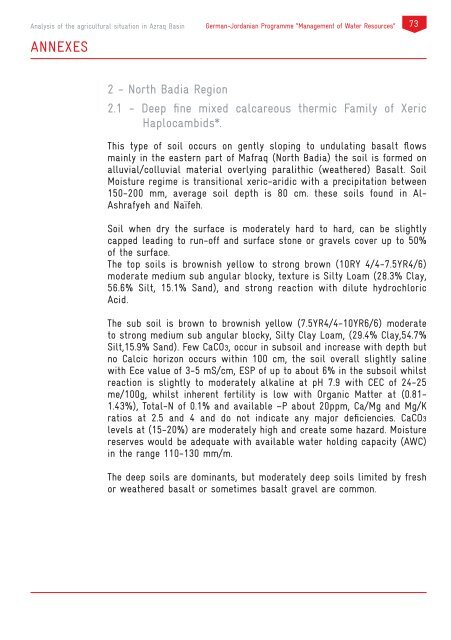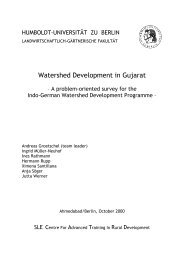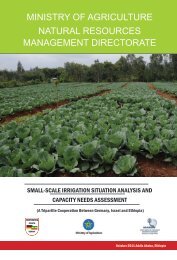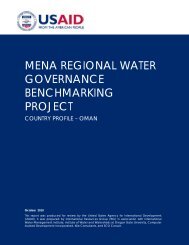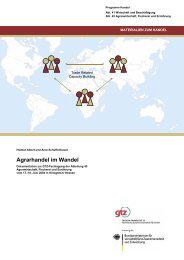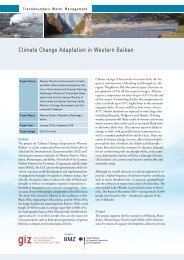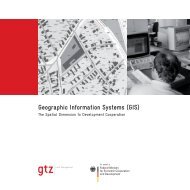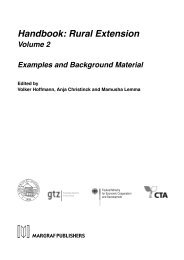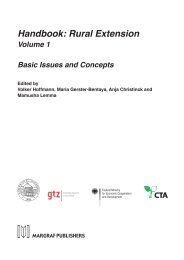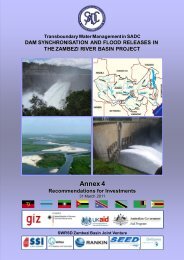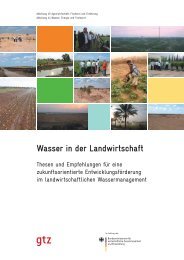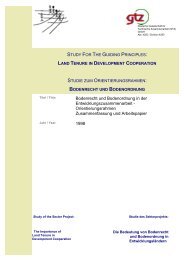Farming in the - WordPress.com
Farming in the - WordPress.com
Farming in the - WordPress.com
Create successful ePaper yourself
Turn your PDF publications into a flip-book with our unique Google optimized e-Paper software.
Analysis of <strong>the</strong> agricultural situation <strong>in</strong> Azraq Bas<strong>in</strong><br />
ANNEXES<br />
German-Jordanian Programme “Management of Water Resources”<br />
73<br />
2 - North Badia Region<br />
2.1 - Deep f<strong>in</strong>e mixed calcareous <strong>the</strong>rmic Family of Xeric<br />
Haplocambids*.<br />
This type of soil occurs on gently slop<strong>in</strong>g to undulat<strong>in</strong>g basalt flows<br />
ma<strong>in</strong>ly <strong>in</strong> <strong>the</strong> eastern part of Mafraq (North Badia) <strong>the</strong> soil is formed on<br />
alluvial/colluvial material overly<strong>in</strong>g paralithic (wea<strong>the</strong>red) Basalt. Soil<br />
Moisture regime is transitional xeric-aridic with a precipitation between<br />
150-200 mm, average soil depth is 80 cm. <strong>the</strong>se soils found <strong>in</strong> Al-<br />
Ashrafyeh and Naïfeh.<br />
Soil when dry <strong>the</strong> surface is moderately hard to hard, can be slightly<br />
capped lead<strong>in</strong>g to run-off and surface stone or gravels cover up to 50%<br />
of <strong>the</strong> surface.<br />
The top soils is brownish yellow to strong brown (10RY 4/4-7.5YR4/6)<br />
moderate medium sub angular blocky, texture is Silty Loam (28.3% Clay,<br />
56.6% Silt, 15.1% Sand), and strong reaction with dilute hydrochloric<br />
Acid.<br />
The sub soil is brown to brownish yellow (7.5YR4/4-10YR6/6) moderate<br />
to strong medium sub angular blocky, Silty Clay Loam, (29.4% Clay,54.7%<br />
Silt,15.9% Sand). Few CaCO3, occur <strong>in</strong> subsoil and <strong>in</strong>crease with depth but<br />
no Calcic horizon occurs with<strong>in</strong> 100 cm, <strong>the</strong> soil overall slightly sal<strong>in</strong>e<br />
with Ece value of 3-5 mS/cm, ESP of up to about 6% <strong>in</strong> <strong>the</strong> subsoil whilst<br />
reaction is slightly to moderately alkal<strong>in</strong>e at pH 7.9 with CEC of 24-25<br />
me/100g, whilst <strong>in</strong>herent fertility is low with Organic Matter at (0.81-<br />
1.43%), Total-N of 0.1% and available –P about 20ppm, Ca/Mg and Mg/K<br />
ratios at 2.5 and 4 and do not <strong>in</strong>dicate any major deficiencies. CaCO3<br />
levels at (15-20%) are moderately high and create some hazard. Moisture<br />
reserves would be adequate with available water hold<strong>in</strong>g capacity (AWC)<br />
<strong>in</strong> <strong>the</strong> range 110-130 mm/m.<br />
The deep soils are dom<strong>in</strong>ants, but moderately deep soils limited by fresh<br />
or wea<strong>the</strong>red basalt or sometimes basalt gravel are <strong>com</strong>mon.


